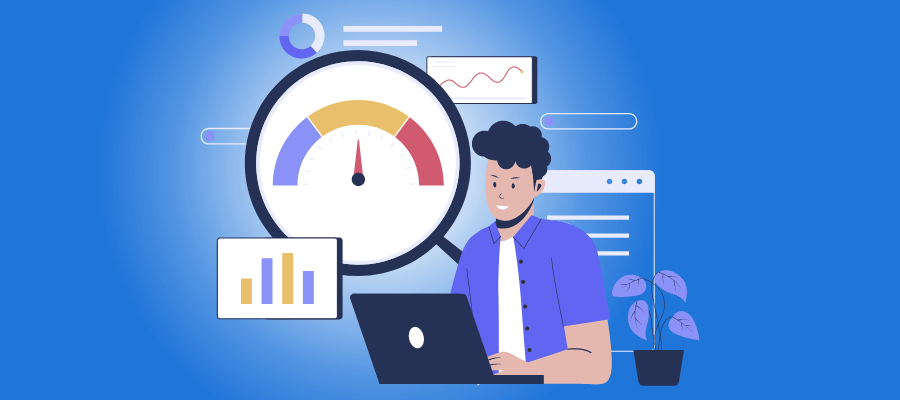We analyzed 12,852 data science jobs from different job portals such as LinkedIn Jobs, Payscale, Glassdoor, Talent, and more.
The goal?
To understand the current state of the data science job market. This includes studying:
- Average data science salary
- Role of experience in payscale
- Breakdown of average salary by regions
- Top data science skills demanded by recruiters
- Minimum qualification to become a data scientist
- Industries with the most number of data science jobs, etc.
Key highlights of the study
- Full-time jobs make up the vast majority (91.8%) of available data science jobs.
- Part-time jobs (2.3%), tenure track (1.0%), and temporary positions (0.6%) are relatively uncommon for data science roles.
- The Information Technology sector has the highest number of available data science jobs (34.5%).
- Other top industries include Management & Consulting (10.9%), Finance (10.6%), and Education (10.7%).
- Manufacturing (1.3%) and Retail & Wholesale (1.2%) have the least number of data science job openings.
- Python, Machine Learning, Data Science, and SQL are the most sought-after skills for data science jobs.
- Most data science jobs require at least a Bachelor’s degree (49%).
- A Master’s degree (38%) can increase the chances of getting a higher-paying job.
- Doctoral degrees (8%) are typically required for research and development roles.
- Data science salaries increase significantly with years of experience, from an average of $78,800 for 0-4 years to $130,000 for 20-24 years of experience.
- Apple ($174,214), Capital One ($166,053), and Meta ($163,518) are among the highest-paying companies for data scientists.
- There is a gender disparity in the data science field, with 67.8% of data scientists being male and only 31.2% being female.
- The United States ($132K – $190K), Australia ($114,788), and Canada ($103,522) offer the highest average annual salaries for data scientists.
- Countries like India ($13.3K) and Sweden ($48.13K – $63.39K) have relatively lower average salaries for data scientists.
What’s covered in this data science jobs report:
1. What is the distribution of available jobs across different job types?
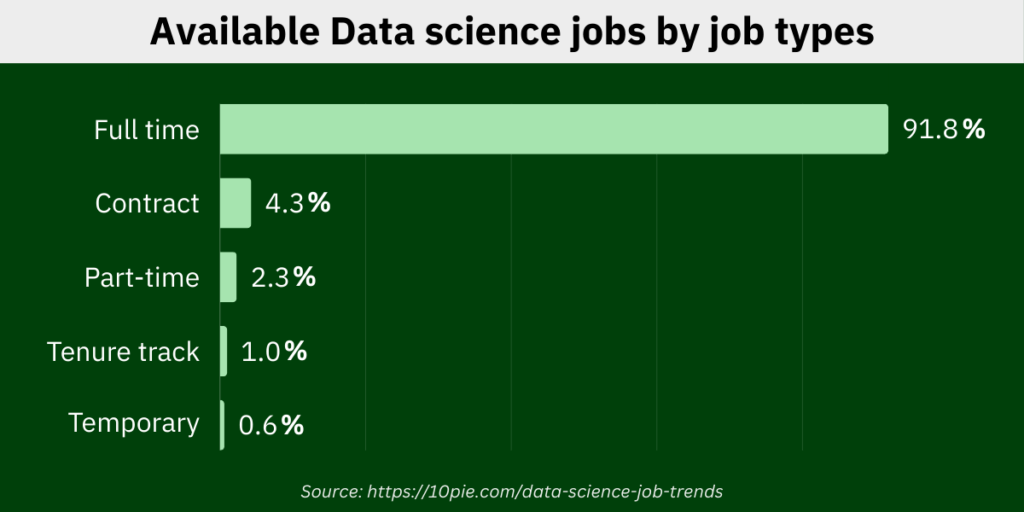
The chart above shows the distribution of available data science jobs across different job types based on a sample size of 12,852 jobs. According to the report, full-time jobs make up the vast majority (91.8%) of the total, and the next highest percentage is contractual jobs.
| Data science Job Type | Percentage of total jobs |
| Full-time | 91.8% |
| Contract | 4.3% |
| Part-time | 2.3% |
| Tenure track | 1.0% |
| Temporary | 0.6% |
| n = 12852 | |
Part-time jobs are only 2.3% of the total. And tenure track positions and temporary positions are even less, with 1.0% and 0.6%, respectively.
It can be because most data scientists are involved in long-term continuous projects, thus not suitable for part-timers or tenure-based people.
Plus it takes time for a data sciences person to get accustomed to all the ins and outs of the business to give valuable feedback. Changing them frequently will waste a lot of time in onboarding, defeating the purpose of being efficient. Besides temporary employees, there can be an issue of data breach and loss of confidential data.
Therefore, your chances of getting a data science job in India will be highest if you look out for full-time positions.
2. Which industry has the highest number of available data science jobs?
| Industry type | No. of available jobs | Percentage of total jobs |
| Aerospace & Defence | 895 | 7.4% |
| Education | 1296 | 10.7% |
| Energy, Mining, Utilities | 567 | 4.7% |
| Finance | 1287 | 10.6% |
| Healthcare | 688 | 5.7% |
| Information Technology | 4181 | 34.5% |
| Insurance | 330 | 2.7% |
| Management & Consulting | 1325 | 10.9% |
| Manufacturing | 163 | 1.3% |
| Media & Communication | 373 | 3.1% |
| Pharmaceutical & Biotechnology | 861 | 7.1% |
| Retail & Wholesale | 151 | 1.2% |
| n = 12117 | ||
The data suggests that based on a sample size of 12,117 data science jobs, the majority are recruited in the IT sector. Management & Consulting (1,325 jobs) and Finance (1,287 jobs) are the other two sectors with a significant number of data science job openings, at 10.9% and 10.6% respectively.
It can be because all of the above-mentioned industries require help with aspects like fraud detection, process automation, customer segmentation and so on to take more data-driven actions.
However, you also get scope in sectors like Education (10.7%), Aerospace & Defence (7.4%), Healthcare (5.7%), and Pharmaceutical & Biotechnology (7.1%).
In the education sector, you are most likely to secure a teaching job, as more and more school graduates are eager to learn data science.
While in aerospace and defence, you can expect to perform predictions, anomaly detection and root cause analysis of aircraft.
In healthcare, data scientists use data to diagnose illnesses, develop personalized treatments and detect patterns to indicate the emergence of infections and diseases.
But the least number of data science job openings are in sectors like Energy, Mining, & Utilities (4.7%), Insurance (2.7%), Retail & Wholesale (1.2%), and Manufacturing (1.3%).
So, statistically speaking, you are more likely to get a data science job in an IT firm or management and consulting corporation.
3. Which region offers the highest average salary in the US?
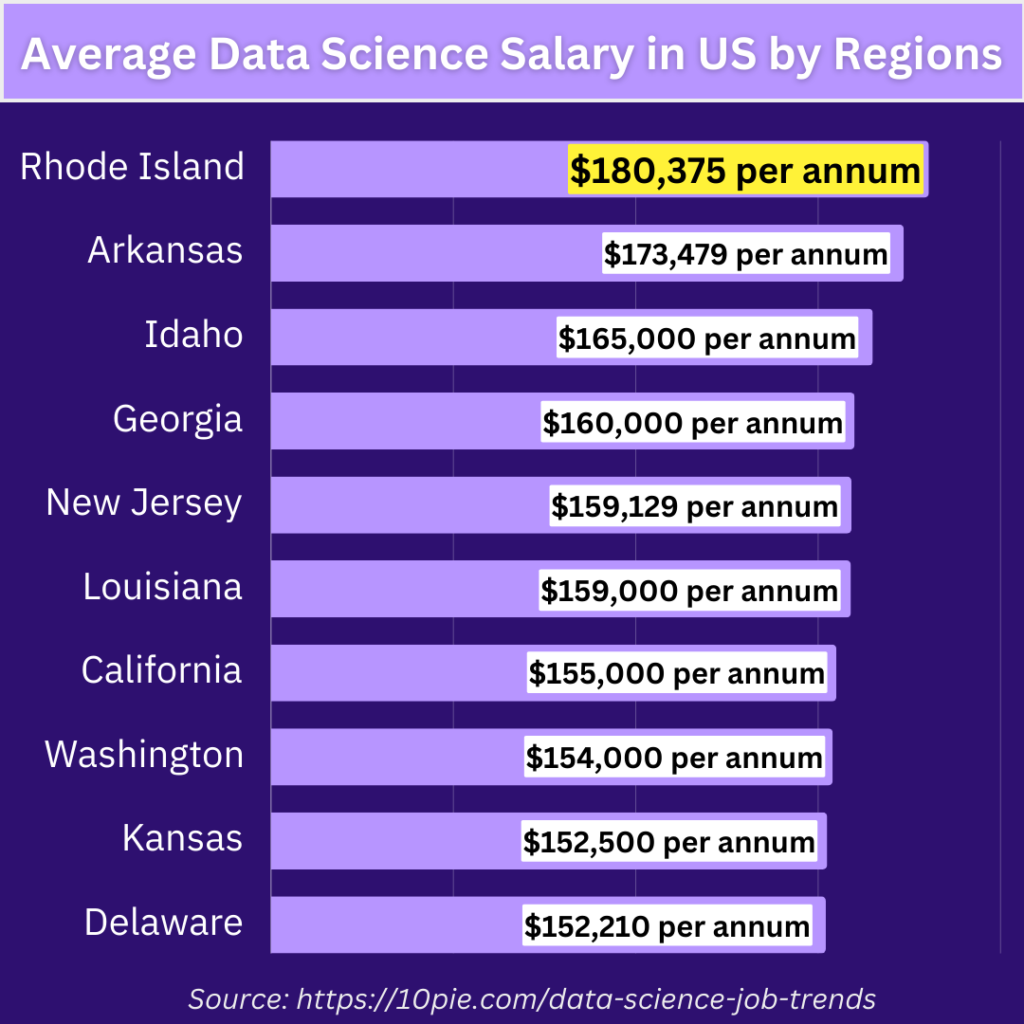
Where you get placed in the US also influences how much you get paid. According to our research, Rhode Island in the US pays the highest salaries for data scientists whereas Delaware pays the least.
However, Rhode Island also has a higher (almost 13% higher than the national average) cost of living than most states in the US. California, New Jersey, and Washington also fall under the same category.
| Region | Average annual salary |
| Rhode Island | $180,375 |
| Arkansas | $173,479 |
| Idaho | $165,000 |
| Georgia | $160,000 |
| New Jersey | $159,129 |
| Louisiana | $159,000 |
| California | $155,000 |
| Washington | $154,000 |
| Kansas | $152,500 |
| Delaware | $152,100 |
So, if you want to spend less, you can look for jobs in regions like Arkansas that have a lower (around 14% less than the national average) cost of living. Or Georgia, where you can save a lot on basic necessities like housing, utilities, food, and healthcare.
4. What are the top data science skills based on job descriptions?
- Python
- Machine Learning
- Data Science
- SQL
- Deep Learning
- Data Analysis
- Artificial Intelligence
- Data Mining
- Analytics and Analytical
- Computer science
- R
- NLP
- Open Source
(n = 10246)
After analyzing almost 10,246, we found out that the top skill required for data science jobs is knowing the programming language Python. Python is not only used in the US but is also the most weirdly used programming language in the world for data science.
The list above is in the order of most important to least important. So, once you learn Python, your next target should be Machine Learning, as it is a key component of data science, and data scientists use it to create models and algorithms that can help companies solve problems.
Although AI has been the talk of the town for quite some time now, it is not a big priority for data science jobs. You can keep it for later, along with skills like Natural Language Processing (NLP) and Open Source.
5. What qualification is required for a data science job in 2024?
| Education level | % of jobs |
|---|---|
| Bachelor’s degree | 49 |
| Master’s degree | 38 |
| Doctoral Degree | 8 |
| High school diploma or GED | 3 |
| Associate’s degree | 2 |
In most cases, you will need a bachelor’s degree in a relevant subject to get an entry-level data science job. However, if you can wait two more years and get a Master’s degree, your scope of getting a comparatively high-paying job increases.
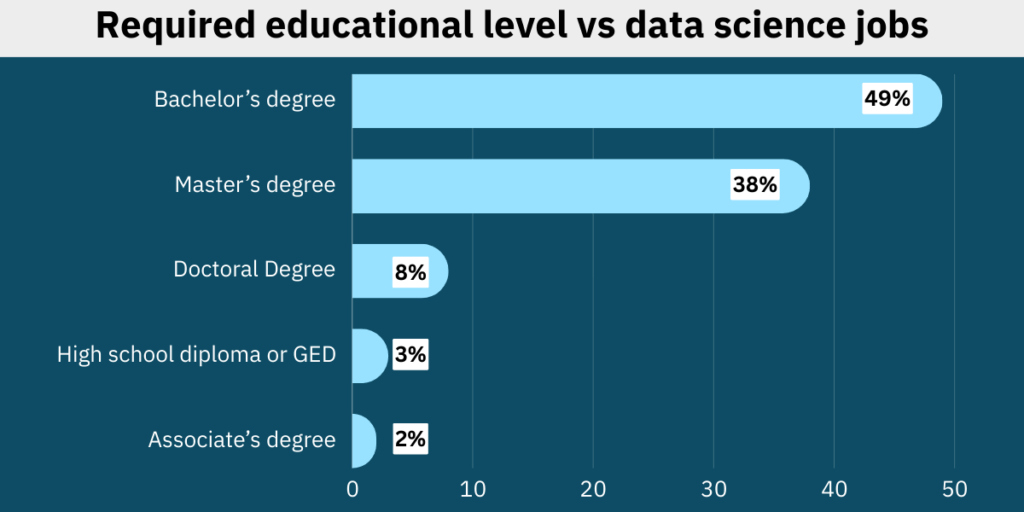
Not many companies will ask you for a Doctoral Degree unless it is for a top-level data science job. However, if you want to be part of a research and development team, you will be required to have a PhD in Data science.
There are not many employers who are candidates with high school diplomas or GEDs. So you at least need to complete your Bachelor’s degree to get a decent-paying job in Data Science.
6. How does work experience level affect data science job salaries?
| Years of experience | Average annual salary ($) |
| 0-4 | 78800 |
| 4-8 | 96800 |
| 8-12 | 115600 |
| 12-16 | 123800 |
| 16-20 | 129300 |
| 20-24 | 130000 |
The difference in pay based on your years of experience is quite standard.
As a beginner with 0-4 years of experience, you can expect to get paid $78,800 per annum. However, after five years, your pay might reach $96,800. It is a 22.84% increase in five years, which is around a 4.6% salary increment every year.
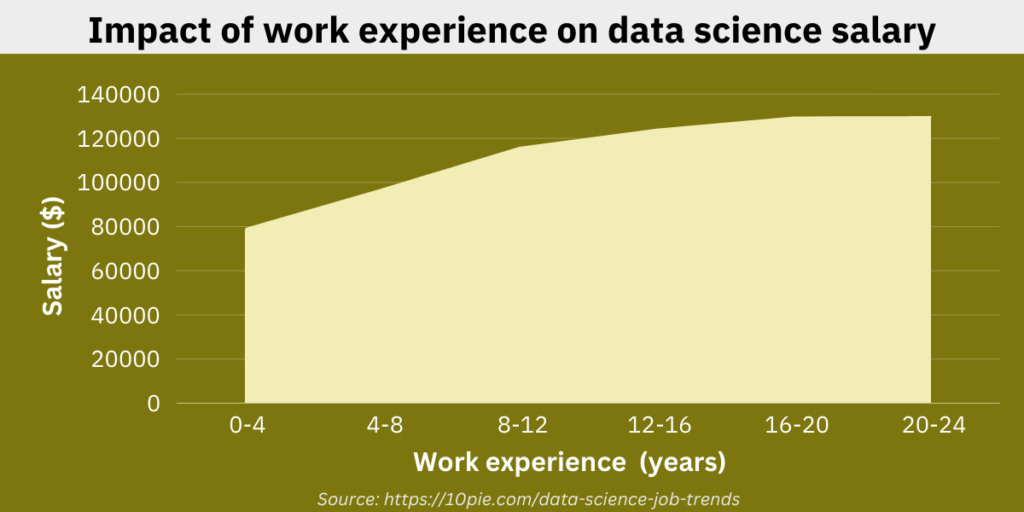
From the table above, you can see that there is not much difference in the annual income of a person with 16-20 years of experience compared to a person with almost 4 years of experience.
7. What are the highest-paying companies in the world?

| Highest paying companies | Average annual salary ($) |
| Apple | $174,214 |
| Capital One | $166,053 |
| Meta | $163,518 |
| $158,594 | |
| $156,635 | |
| Intel Corporation | $150,938 |
| Oracle | $148,569 |
| Amazon.com | $146,552 |
| Walmart | $145,606 |
| Microsoft | $142,522 |
The salary you can earn through data science significantly depends on the company you get to work in. In the list above, we have presented all the top companies and their average annual salary for data scientist roles.
According to our research, we were surprised to find that Apple pays the highest to data scientists. Whereas companies like Google, which presumably have a lot more association with big data, pay slightly less than that.
Thus, it would be unfair to think that only IT companies pay the highest to data scientists. You should also look around at other Fortune 500 companies in different sectors like electronics and social technology companies.
8. What is the gender breakdown of data scientists?
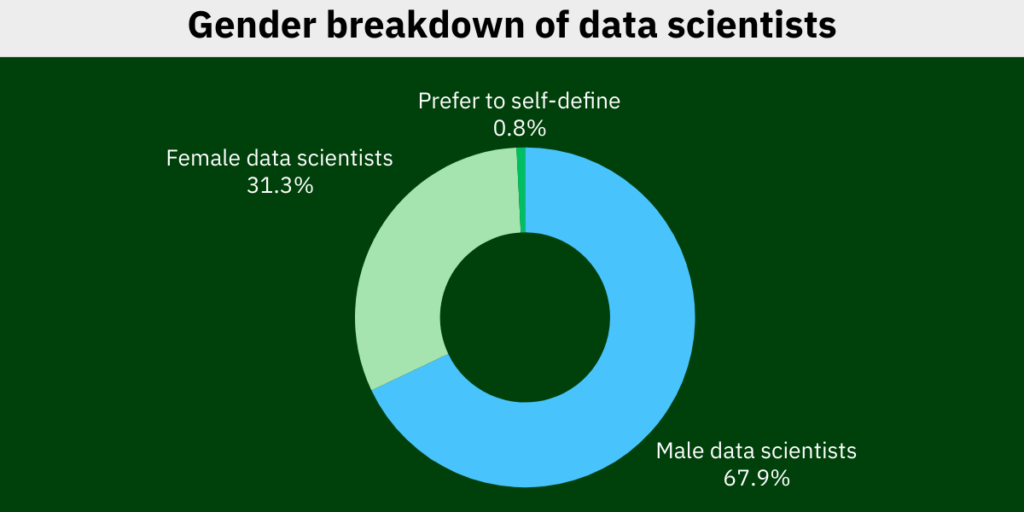
| Gender | % of jobs |
| Male | 67.8 |
| Female | 31.2 |
| Prefer to self-define | 0.8 |
n = 2907
Unfortunately, the gender disparity is quite striking in data science careers. Based on 2097 responses, we discovered that almost two-thirds of the total number were males, while only one-third were female.
There could be a lot of reasons behind that, including gender stereotyping, lack of role models, and poor career development due to working in a male-dominated workplace.
However, the statistics should motivate females even more to pursue data science as a career and address this gender gap.
9. What is the average base salary of data scientists around the world?
| Country | Average Annual Data Scientist Salary | Converted into $ |
| United States | $132K – $190K | $132K – $190K |
| United Kingdom | £50,948 | $65,455 |
| Canada | $103,522 | $103,522 |
| Australia | $114,788 | $114,788 |
| Germany | €60K – €75K | $65,648 – $82,060 |
| Netherland | €52T – €80T | $56.90K – $87.54K |
| Sweden | SEK 492K to SEK 648K | $48.13K – $63.39K |
| India | ₹11,00,322 | $13.3k |
| Singapore | SGD 96K – SGD 168K | $72.15K – $126.26K |
| Denmark | DKK 492K to DKK 600K | $72.24K – $88.10K |
Due to purchasing power parity (PPP), salaries fluctuate drastically in different countries. This is why you will find most of the first-world countries paying almost ten times more to the data scientists than what they get paid in India.
But keep in mind that their cost of living is significantly high, too.
So, where in India, you can live a comfortable life in a metro city with a salary of $13.3K/ annum, you might struggle with even $132K if you live in California (the US).
For example, the average living cost in Indian metro cities is around ₹50,000 ($600)/ month for a single person. Also, here we are talking about an affluent lifestyle.
But the same person would need to spend an average of $3,555/ month. And it will even go higher for prime locations like New York, California, Florida etc.
So, it is not always a great idea to move out to another country just because their pay seems tenfold better than what you are getting; always consider the expenses, too.
How we collected data
To get insights and statistics, we relied on publicly available data from various job portals such as LinkedIn Jobs, Payscale, Glassdoor, Talent, Indeed, etc.
We then gathered and organized these into the report format to make a broader picture of the data science job market.
However, one limitation of this report is that over time the data may change depending on the job portals. This is why we will redo our research every year to make the report accurate and fresh.
Sources and references
- https://www.glassdoor.co.in/
- https://www.glassdoor.co.in
- https://www.talent.com/
- https://www.ambitionbox.com/
- https://www.indeed.com/
- https://www.indeed.com/
- https://www.indeed.com/
- https://www.payscale.com/
Summary
In summary, I can say that this is the best time for you to get into data science. In the next five to ten years, the demand for data scientists is going to go up. And with the right set of skills and the right choices, you can make millions.
If you are already a graduate and want to start looking for jobs, remember the key highlights I shared at the beginning. Explore non-IT fields; don’t move out if it’s not necessary, and keep upskilling as data science is constantly.

Mrittika Sengupta is a professional content writer with more than 2 years of experience in writing for some of the popular blogs on marketing and tech fields. She also mentors aspiring writers transitioning from academia to the commercial writing world.

